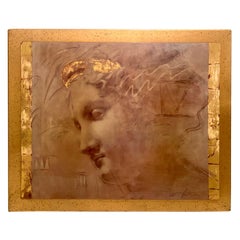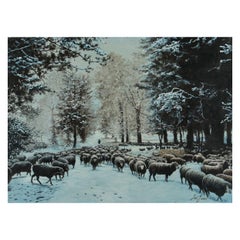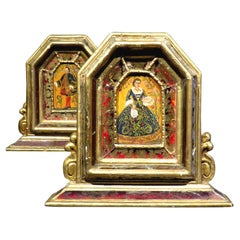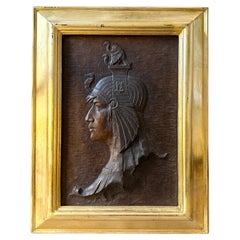Giltwood Decorative Art
20th Century Italian Mid-Century Modern Giltwood Decorative Art
Giltwood
20th Century Irish Victorian Giltwood Decorative Art
Canvas, Giltwood
20th Century Irish Victorian Giltwood Decorative Art
Canvas, Giltwood
Early 1900s European Baroque Antique Giltwood Decorative Art
Gesso, Wood, Giltwood, Paint
1940s American Classical Greek Vintage Giltwood Decorative Art
Gold Leaf
Early 20th Century Italian Art Deco Giltwood Decorative Art
Giltwood, Plaster
20th Century Italian Giltwood Decorative Art
Paper, Giltwood
20th Century French Giltwood Decorative Art
Giltwood, Paper
20th Century French Rococo Revival Giltwood Decorative Art
Enamel
Mid-20th Century Belle Époque Giltwood Decorative Art
Giltwood
20th Century French Giltwood Decorative Art
Silk, Giltwood
Early 20th Century Italian Rococo Giltwood Decorative Art
Canvas, Giltwood
Mid-20th Century Classical Greek Giltwood Decorative Art
Brass
Early 20th Century English Victorian Giltwood Decorative Art
Giltwood, Paint
1950s Chinoiserie Vintage Giltwood Decorative Art
Wood, Giltwood, Paper
Mid-20th Century European Neoclassical Giltwood Decorative Art
Gold, Brass
20th Century Modern Giltwood Decorative Art
Giltwood, Canvas, Wood, Paint
20th Century French Giltwood Decorative Art
Giltwood, Paint
Early 20th Century Austrian Giltwood Decorative Art
Canvas, Wood, Giltwood
20th Century French Giltwood Decorative Art
Silk, Giltwood
20th Century Unknown Modern Giltwood Decorative Art
Wood, Paint, Giltwood, Canvas
Early 20th Century French Empire Giltwood Decorative Art
Canvas, Giltwood
Mid-20th Century French Mid-Century Modern Giltwood Decorative Art
Canvas, Giltwood
Early 20th Century English Edwardian Giltwood Decorative Art
Canvas, Giltwood
Early 20th Century Russian Giltwood Decorative Art
Canvas, Giltwood
Early 20th Century American Folk Art Giltwood Decorative Art
Foil
1940s Unknown Modern Vintage Giltwood Decorative Art
Canvas, Wood, Giltwood, Paint
20th Century French Baroque Giltwood Decorative Art
Giltwood
1960s Unknown Mid-Century Modern Vintage Giltwood Decorative Art
Giltwood, Canvas, Wood, Paint
20th Century American Mid-Century Modern Giltwood Decorative Art
Giltwood, Masonite
Early 1900s Italian Baroque Antique Giltwood Decorative Art
Canvas, Giltwood
1920s Unknown Modern Vintage Giltwood Decorative Art
Giltwood, Wood, Paint
Early 20th Century French Art Deco Giltwood Decorative Art
Canvas, Giltwood
20th Century Unknown Mid-Century Modern Giltwood Decorative Art
Paint, Giltwood, Canvas, Wood
Early 1900s Italian Baroque Antique Giltwood Decorative Art
Canvas, Giltwood
20th Century French Giltwood Decorative Art
Silk, Giltwood
20th Century Unknown Modern Giltwood Decorative Art
Paint, Wood, Giltwood
Early 20th Century Chinese Qing Giltwood Decorative Art
Wood, Giltwood
1980s American Other Vintage Giltwood Decorative Art
Canvas, Giltwood
Early 20th Century French Giltwood Decorative Art
Giltwood
1980s American Post-Modern Vintage Giltwood Decorative Art
Pewter
Early 1900s German Baroque Revival Antique Giltwood Decorative Art
Porcelain, Giltwood
1920s American Baroque Vintage Giltwood Decorative Art
Canvas, Giltwood
1910s Unknown Romantic Vintage Giltwood Decorative Art
Canvas, Giltwood
Mid-20th Century French Giltwood Decorative Art
Giltwood
Early 20th Century French Louis XVI Giltwood Decorative Art
Giltwood
Early 1900s Antique Giltwood Decorative Art
Giltwood
Late 20th Century British Giltwood Decorative Art
Giltwood
Early 1900s French Belle Époque Antique Giltwood Decorative Art
Glass, Giltwood, Paper
20th Century North American Giltwood Decorative Art
Canvas, Giltwood
20th Century French Giltwood Decorative Art
Giltwood, Paint
Early 1900s Italian Country Antique Giltwood Decorative Art
Gesso, Canvas, Giltwood
Late 20th Century Italian Neoclassical Revival Giltwood Decorative Art
Glass, Giltwood, Paper
Early 20th Century Burmese Art Deco Giltwood Decorative Art
Wood, Giltwood
Mid-20th Century French Mid-Century Modern Giltwood Decorative Art
Paint, Canvas, Giltwood
Early 20th Century Belle Époque Giltwood Decorative Art
Brass
20th Century Italian Louis XVI Giltwood Decorative Art
Giltwood
Early 20th Century German Greco Roman Giltwood Decorative Art
Canvas, Giltwood
Read More
At Colonial Williamsburg, Everything Old Is New Again
With the help of a new director, the Virginia institution's folk art and decorative arts museums are undergoing extensive upgrades.
New York’s Hirschl & Adler Showcases the American Workmanship and Design Panache of Neoclassical Treasures
The gallery's latest exhibition proves that museum-quality pieces entice and inspire, whether in traditional or more modern interiors.





